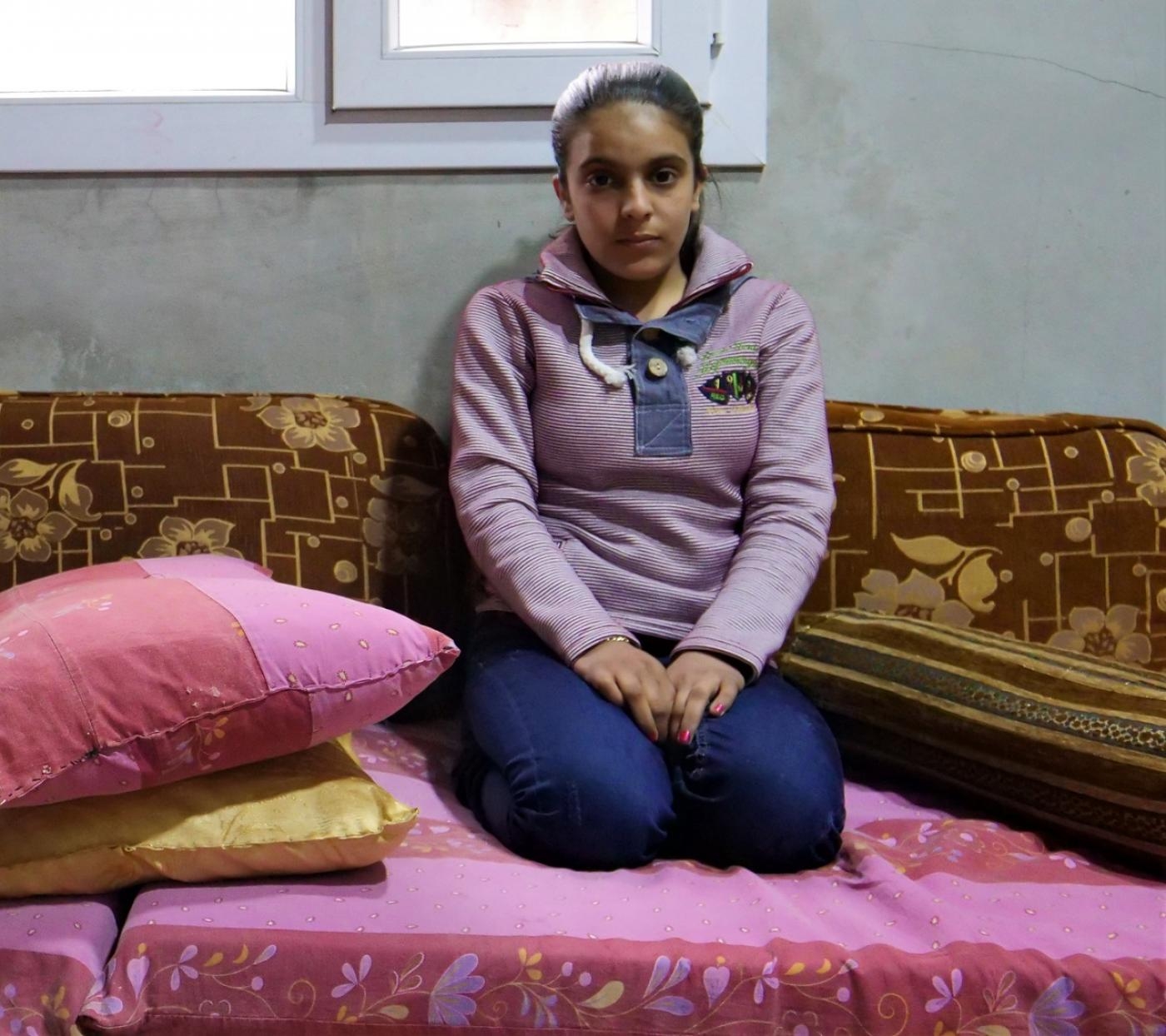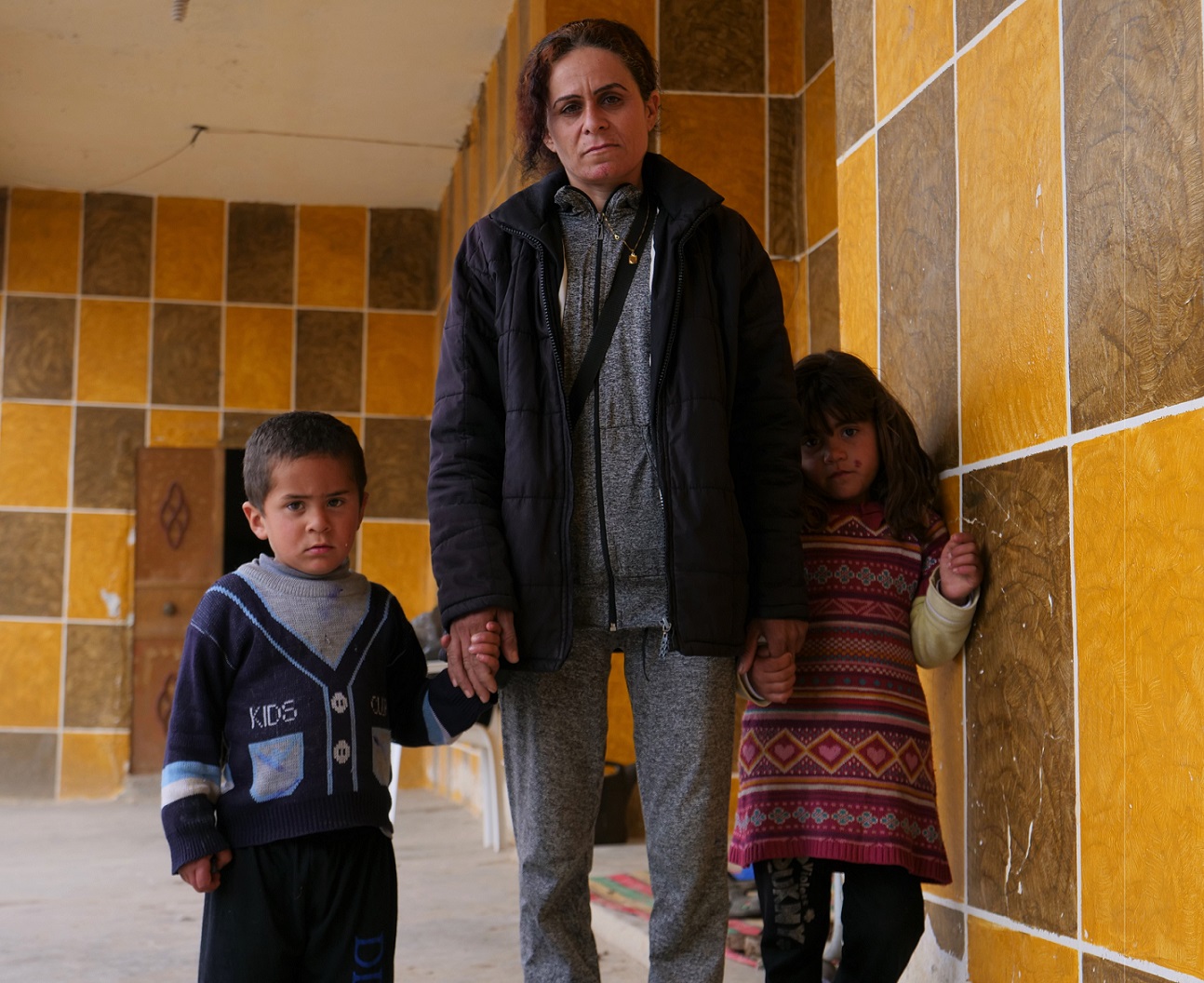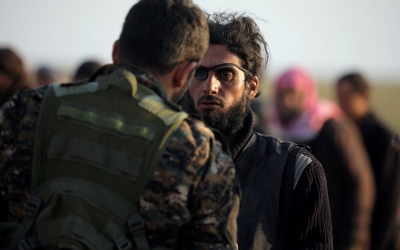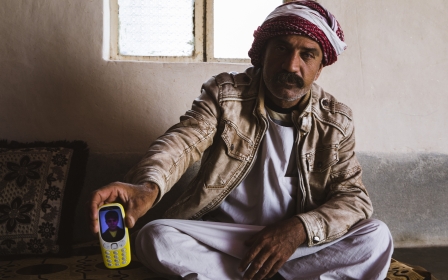The Yazidis of the Caliphate's 'last breath'

Souad's hair is brushed with care. She wears a pink sailor sweater and has polished her nails with the same colour.
You'd think she was a girl like any other. Yet five days ago, this Yazidi teenager fled her torturers during the fierce fighting in Baghouz, the last enclave of the Islamic State (IS) in Syria.
Now she is able to remove her niqab in a windy tent in a Dantean desert. At 15, Souad was held captive for more than four years by the group.
To her right sits frightened Jolyn, named Hind by those who reduced her to slavery when she was only six years old. She is now 10.
They have taken refuge in the homes of Yazidi inhabitants of the governorate of al-Hasakah, in northeastern Syria, and are waiting for a still unconfirmed repatriation to Iraqi Sinjar, where they are from.
New MEE newsletter: Jerusalem Dispatch
Sign up to get the latest insights and analysis on Israel-Palestine, alongside Turkey Unpacked and other MEE newsletters
And where, one evening in August 2014, Souad's family was slaughtered, like a large part of her community, which Daesh (an alternative name for IS) deemed "unfaithful". Nearly 3,000 are dead and more than 6,000 missing.
'During four years, I was sold every three months, locked in rooms, handcuffed, locked in car trunks, raped'
- Jane
"All I have is my sister. I don't even remember what my house looks like," said Souad in Arabic.
In Kurdish-speaking countries, IS made them lose their mother tongue.
In the attitudes of these former sabayas (sexual slaves), the ghost of the executioners shows through.
The older one, with her defensive gaze, is incisive. The youngest remains silent, eyes lowered, and touches her feet frantically.
"We didn't know each other before we ran away. Daesh simply told us: 'go ahead, you are free,' and we followed the civilians," said Souad, who is nestled in the living room of a host family in the Yazidi village of Gondor.
These young girls seem lost between two worlds at odds, having left the daily violence and bombs for the peaceful setting of an unknown family.
They do not address the sexual crimes and atrocities of the past. They are young, alone in the face of a new existence, and traumatised.
How long will it take Jolyn's mother, who has just returned to Mount Sinjar from Germany, where she was a refugee, to find her daughter?
With only her knowledge of Arabic, Jolyn doesn't want to communicate over the phone.
Nomadic abuse
"I've been through a lot. I don't know the names of all the regions, but I was brought to Tal Afar, Mosul, Raqqa, Hajine... al-Baghouz," said Souad.
The names of all these cities evoke the abuses and violations perpetrated by IS.
"The man who marked me the most was Abu Fayzah al-Kazakstani. I stayed with him for a long time in Raqqa and then he died," said Souad.
Trapped in her situation, Souad is too young to understand the inhumanity she has suffered.
"I was afraid of bombings, planes, but I was used to it," said Souad.
"Now I want to stay home and not go to school, like under Daesh."
'My children were taken away for two months'
Pregnant at the time of the kidnapping, Jane, another Yazidi survivor living in a remote village of the al-Hasakah region, gave birth to her last son, Ahmed, under the "caliphate".
He will never meet his father, beheaded in front of his mother and brothers.
Talking about her path of enslavement is stressful for this thin woman with a scarred face.
"I'm in psychological pain, what they did to us is too hard to explain," she said.
"During four years, I was sold every three months, locked in rooms, handcuffed, locked in car trunks, raped. Once, my children were taken away for two months."
The most demeaning ordeal she's ever been through? Torture treatments inflicted by foreign women of IS, particularly French women.
The escape and fear of discovery
Jane remembers the escape from Baghouz.
"During a curfew, vans [of the Syrian Democratic Forces] came to to take us to al-Hawl camp."
Located east of al-Hasakah, the camp hosts civilians and wives of IS fighters who fled the fighting in Baghouz. There, the Yazidis didn't dare to declare their true identity.
"Daesh told us that the Kurds would kill us if we revealed our origin. I believed it," said Jane.
The constant need to hide their identity ended thanks to her son, seven-year-old Ferdi.
Sick, he was transferred to the hospital in al-Shaddadi, where he confessed to the caregivers that he was Yazidi.
At the hospital, Ferdi spoke in literary Arabic, which caught the doctor's attention, as only IS foreigners use it.
To protect himself, the boy pretended to be Maghrebian. But his accent deceived him. "I am a Yazidi of Shingal [Sinjar in Kurdish]," he then confessed.
His mother, Jane, was awaiting him in a tent in the camp.
"Members of the SDF came and asked the foreign jihadist women to leave and ordered me to follow them. When I arrived in an office, I burst into tears," she says.
"They asked me why. 'Because I'm a Yazidi and you're going to kill me!' They promised to take me back to Shingal.
"If my son hadn't been sick, I would still be in a camp tent, with no future. I am finally delivered," sighed Jane.
Mahmoud Racho, who now shelters the mother and her three children, says it was lucky Ferdi knew he was a Yazidi, "because at this age, they often don't remember their origins".
In al-Hawl, Jane dressed in a niqab to go unnoticed and helped identify other Yazidis "to save them".
In addition to the fear of Arab-Kurdish forces instilled in them by IS, some of them are also scared to reveal their identity for fear of the rejection that their children born of "horror", might experience.
Psychological support
As soon as they are under the custody of the SDF - the US-backed Arab-Kurdish coalition that fights against IS - the former prisoners of the group are escorted to Syrian Yazidi host families.
"When they arrive, they are housed at the homes of community members," says Ilyasse Ibrahim Seydo, a member of the Yazidi House Committee in al-Hasakah province.
"We do not want to leave them in shelters or camps, we want to allow them to readapt and provide them with psychological support before returning to Sinjar.
"It is difficult to know their stories and the torture they have suffered. What we know is that according to Daesh's laws, one can be a sexual slave from the age of seven," says Ilyasse angrily.
Along with his family, Ilyasse, who currently hosts Souad and Jolyn, did everything possible to reassure the Yazidis they took under their wing.
"I talk mainly to boys and will leave it to the Sinjar Yazidi Committee to help deliver girls' voices. Now, it is still too early," he says.
Thanks to Ilyasse's children, Souad and Jolyn now laugh, play and even listen to music, which would have been unthinkable under IS.
"They were not even allowed to go out. I think that Souad, the older one, is indoctrinated. At these ages, Daesh's ideology is easily assimilated," said Ilyasse.
"Some children don't even remember that they are Yazidis."
'Caliphate cubs'
While waiting to be returned, Jane is living with two recently released Yazidi teenage boys.
"Daesh wanted to make us 'caliphate cubs'. We were taught to handle weapons, and given a kounya [nickname]. I was Anes Abou Khatab," said Jelil, 15.
According to Jelil, 80 percent of the "caliphate cubs", young Yazidis forced to fight in the ranks of IS, died in combat.
Treated as an armed servant, Jelil managed to escape from his master, a Syrian.
"Mine, a Saudi Arabian named Abu Bassir al-Jezire, has explosive belts and artillery at home. He will fight to the end," added Ayemen, 16, who has an injury to his left leg.
"He had chosen my kounya because of my origin: Abu Younes al-Sinjari," he says, while smoking a cigarette, an act prohibited under the caliphate.
'Islamic State's last human shield'
More than 3,000 Yazidis have been rescued since the beginning of IS's territorial expansion, including about 60 women and children in the last area under the group's control, Baghouz.
But for them, the Kafkaesque situation continues.
Iraqi regional divisions are now hindering the future of women survivors of IS.
For nearly two months, returns to Iraq have been taking place in secret.
"The Iraqi government has closed off access to Sinjar to us," said Ilyasse. "The escort of the last convoy of 21 people to Sinjar has been blocked on the Iraqi side for the past three days."
Asked what he think the cause is, he says: "Territorial disputes between the opposing forces. Baghdad is preventing us from getting through."
There are still an estimated 250 Yazidis trapped in Baghouz.
Last week's announcement of the discovery of a mass grave containing about 50 beheaded bodies, many of them women, suggests the worst.
"The Yazidis will be the Islamic State's last human shield," believes Ilyasse.
This article was translated from Middle East Eye's French website.
Middle East Eye delivers independent and unrivalled coverage and analysis of the Middle East, North Africa and beyond. To learn more about republishing this content and the associated fees, please fill out this form. More about MEE can be found here.









